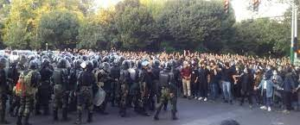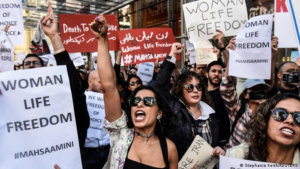November 4th, 2022
Mahsa Amini died on the 16th of September 2022. Her death sparked some of the largest women’s rights protests that Iran has seen in all of its existence.
Throughout its history, starting from its independence declaration, Iran has been a male-dominated, patriarchal country. Iran throughout the 20th century had been making a gradual progression in women’s rights. For example, women got the right to vote in 1963, the right to take part in public office in 1975, and the right to divorce and retake custody of their children in 1975. But, even with these advancements women were still heavily discriminated against and lacked nearly all the privileges that men in Iran enjoyed freely. Then, in the Islamic Revolution of 1979, a new theocratic ruling government took power and stripped women of most of their previously attained rights. This new government has ruled over Iran for over 40 years and still holds women as second-class citizens in Iran.
Modern-day Iran is a sore subject in many areas, especially women’s rights. Currently, it ranks 143rd out of 146 researched countries for women’s rights, equality, and opportunity by the world economic forum. The main reason for the abysmal ranking is the complete restriction of women in the workforce. The women who do hold jobs are incredibly underpaid and have no sense of security for maintaining their employment. Another problem that plagues Iran is its chokehold on women’s clothing. In Iran specifically, there is an authority force called the “Morality Police” which patrols Tehran and other major cities specially used to enforce a mandatory dress code on all women in public spaces. This Morality Police force is just another force that holds back advancement for women in Iran and continues to be another tool to oppress women and keep them subdued to inhumane standards.
All of these previously stated problems about Iran were made more apparent to the world after the news broke of Mansa Amini’s death on September 16th, 2022. Mansa Amini was a tourist from one of Iran’s northwest provinces in Tehran. On September 13th she was exiting a metro station with her brother in the city center when they were approached by the Morality Police. She was arrested for being allegedly dressed inappropriately and later detained in what the authorities call a “re-education center” to be “re-educated” on why the hijab is mandatory in Iran. Normally these sessions take up to one hour in length but Amini’s took days and when she was found again in the lobby of the center she collapsed. The authorities claim that she had a heart attack and was quickly transported to a hospital where entered a coma, suffered another heart attack and died. Her family however tells a different story.
On September 16th, Amini’s family and an Iranian journalist named Niloofar Hamedi came out in an article about the evidence they documented while Mansa was in the hospital. Their proof showed cuts, bruises, and inflicted wounds which supported what they said in the article which was that Mansa had been severely beaten and abused by the Morality Police while in their custody. It was also noted by doctors reviewing the images uploaded by the family that the abuse that Mansa suffered may have been the direct cause of her death. Mansa’s experience with the morality police is not the only case of this happening. Throughout its history, there have been countless allegations of human rights violations by this secret police force but none have gotten the global attention that Mansa’s story obtained. Mansa’s story is not one to be taken lightly and shows how much work can still be done for women all around the globe and especially in Iran. It was the women of Iran who noticed this first and decided to act.

Following Mansa’s death and her experience being published. Thousands of Iranian women have taken to the streets of Tehran, Mashhad, and Karaj to protest the government of Iran and its laws concerning women in Iran. Notably, one famous line that has surfaced from these protests is “Iran is not the Islamic Republic.” This is significant because although the government declares itself the theocratic Islamic Republic, the population of Iran has shown on numerous occasions that they are discontent with being a country governed by Islamic laws. What we are witnessing here in Iran with these protests is what some political activists are calling a “cultural revolution”. These protests could just be the first stepping stone in the path for Iran to join the modern world in an equal society, spurred on by the catalyst of outcry for recognition of women’s rights which had long been ignored.
The fallout from these protests came with progress and some major drawbacks for Iranians. The most beneficial thing that came out of these protests was the worldwide attention that these women got. They were able to speak their minds and fight for what they truly believed in without the fear of disappearing or retaliations. There was also a major push in the United Nations and other foreign governments to pressure Iran to change their laws restricting women through sanctions and other economic means. One major drawback though was the crackdown that ensued following the protests. After the first protests began the entire police force of Tehran was assigned to break down these protests and arrest all participants. So far, nearly a hundred people have been arrested and detained with many being presumed to have been inhumanely arrested without actual charges. Another repercussion of these crackdowns was the deaths that followed. Depending on the source, estimates range from 41-154 people have been killed while protesting by police, security forces, and counter-protesters. These protests have been seen and are perceived as a necessary act to progress human rights in Iran but the violence that has been displayed within the first few weeks has shown that peacefully protesting may not be an option that Iran has.
What does all of this mean for the future of women’s rights in Iran? Well, we have yet to see any positive change or reaction from the ruling government in Iran. They have responded to the protests with police deterrence and have taken notice of the rising international pressure to modify their laws. Right now we cannot know anything for sure about the future of women in Iran. But we can see that if this pressure continues on the government both internally and internationally then we will probably see some progressive change in the country in the coming years. This is why we must continue our international support of women in Iran and continue to advocate for our government to pressure Iran. Overall this situation is seen as the first step towards advancing civil rights not only in Iran but other countries which share Iran’s views on women. This makes it critical that we all continue to pay attention to Iran and not let these women’s fights go to waste.
By Ethan Parkinson
Categories: Editorials




